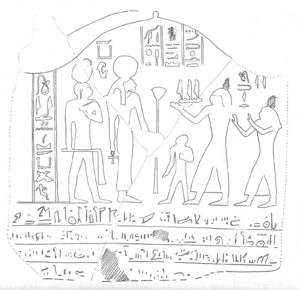Shoshenq IV facts for kids
Quick facts for kids Shoshenq IV |
|
|---|---|

Stela of the "Chief of the Libu" Niumateped, likely issued in regnal year 8 of Shoshenq IV
|
|
| Pharaoh | |
| Reign | 798–785 BC (22nd Dynasty) |
| Predecessor | Shoshenq III |
| Successor | Pami |
| Burial | NRT V, Tanis |
Hedjkheperre Setepenre Shoshenq IV was an ancient Egyptian pharaoh (king). He ruled during the 22nd Dynasty. His reign was between the time of Shoshenq III and Pami. For a long time, historians thought he was the same as an earlier king, Shoshenq I. But new discoveries proved he was a unique ruler.
Contents
Discovering a New Pharaoh
For many years, experts believed there was only one king named Shoshenq with the special royal name Hedjkheperre. This was Shoshenq I, who started the 22nd Dynasty.
How Experts Found Shoshenq IV
In the 1980s, a historian named David Rohl suggested there might be two kings with that name. He called the second one Hedjkheperre Shoshenq (b). Later, in 1993, another expert, Aidan Dodson, found more proof. He showed that the earlier Shoshenq I used simple titles. But the later Shoshenq (who we now call Shoshenq IV) used much more complex titles.
This discovery meant that the king previously known as Shoshenq IV (who had a different royal name, Usermaatre) had to be renumbered. He became Shoshenq VI. The new king, Hedjkheperre Shoshenq (b), was then officially named Shoshenq IV. Today, most Egyptologists agree that Shoshenq IV was a real and separate king.
What Made Him Different?
Shoshenq IV shared the same main royal name (called a prenomen) as Shoshenq I. But his full royal name (called a nomen) was much longer. It included special phrases like "beloved of Amun, son of Bast, divine ruler of Iunu". These extra titles, like "son of Bast" and "divine ruler of Heliopolis," only started being used by kings much later in the 22nd Dynasty. Kings like Osorkon II, Shoshenq III, Pami, and Shoshenq V used them.
In contrast, Shoshenq I's full name was simply "Shoshenq-meryamun" (Shoshenq, beloved of Amun). His immediate successors, Osorkon I and Takelot I, also used only simple titles. This difference in names helped experts realize that the Hedjkheperre Shoshenq with the long name had to be a later king. This means he ruled around the same time as, or after, Shoshenq III.
Evidence from a Stone Tablet
In 1989, David Rohl pointed out that a stone tablet, called a stela, from Year 10 of a king, showed the name Hedjkheperre Shoshenq. This stela mentioned a "Great Chief of the Libu" named Niumateped. This same chief is also mentioned in a Year 8 record, which was usually thought to belong to Shoshenq V.
The title "Chief of the Libu" only appears in records from Year 31 of Shoshenq III onwards. This suggested that the king on the stela must have ruled at the same time as or after Shoshenq III. Aidan Dodson confirmed that the Hedjkheperre Shoshenq on this stela had the long, complex name. This proved the stela could not be from Shoshenq I's time.
Dodson suggested that Shoshenq IV's reign came after Shoshenq III's last known year, which was Year 39. The discovery of Shoshenq IV's burial in Shoshenq III's tomb also supported the idea that he was part of the same royal family line.
Burial Site
Shoshenq IV was buried in the tomb of Shoshenq III. This tomb, called NRT V, is in a place called Tanis. When archaeologists explored the tomb, they found two stone coffins, called sarcophagi. One coffin was for Shoshenq III. The other coffin had no name on it.
However, the unnamed coffin was clearly placed in the tomb later. In the dirt and rubble of the tomb, pieces of one or two canopic jars were found. These jars had the name Hedjkheperre Shoshenq on them. Canopic jars were used to store the organs of the deceased king.
David Rohl noticed that these jars from the tomb were too big to fit into a canopic chest that belonged to Shoshenq I. This was a key clue for his idea that there were two kings named Hedjkheperre Shoshenq. Aidan Dodson also noted that the jars had the long, complex name, including "divine ruler of Heliopolis." This title was not used by 22nd Dynasty kings until Shoshenq III's time. This was strong proof that the new Shoshenq IV was buried in Shoshenq III's tomb and must have ruled after him. It also confirmed that the king in the second coffin was definitely not Shoshenq I.
Even though Dodson was at first unsure about Rohl's idea, his own research into the burial evidence convinced him. He later wrote that his studies led him to support the idea of two kings named Shoshenq with the prenomen Hedjkheperre. This is now the widely accepted view among experts who study ancient Egypt.


